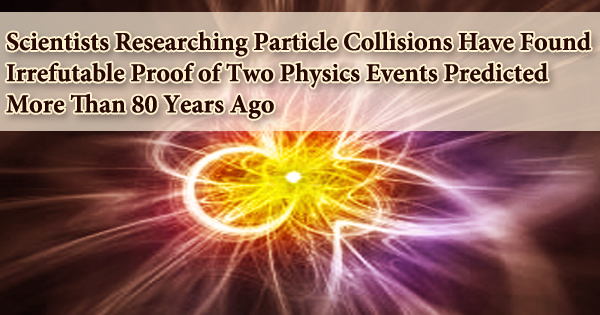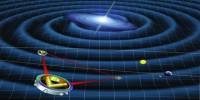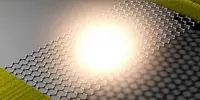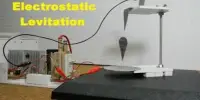Scientists investigating particle collisions at DOE’s Brookhaven National Laboratory’s Relativistic Heavy Ion Collider (RHIC), a US Department of Energy Office of Science user facility for nuclear physics research, have found solid evidence for two physics events predicted more than 80 years ago. The findings were published in Physical Review Letters after a comprehensive examination of more than 6,000 pairs of electrons and positrons generated in glancing particle collisions at RHIC.
The main discovery is that colliding highly energetic photons, which are quantum “packets” of light, may directly produce pairs of electrons and positrons, matter, and antimatter particles. The renowned E=mc2 equation says that energy and matter (or mass) are interchangeable. This conversion of energetic light into the matter is a direct result of Einstein’s famous E=mc2 equation. Matter is converted into energy by nuclear reactions in the sun and in nuclear power plants on a regular basis. Scientists have now successfully turned light energy into the matter in a single step.
The second finding indicates that depending on how light is polarized, the path of light moving through a magnetic field in a vacuum bends differently. When light travels through certain materials, it exhibits polarization-dependent deflection (known as birefringence). (This works in the same manner as wavelength-dependent deflection divides white light into rainbows.) However, this is the first time polarization-dependent light bending has been demonstrated in a vacuum.

Both discoveries rely on the Solenoid Tracker at RHIC’s STAR detector’s capacity to monitor the angular distribution of particles generated in glancing collisions of gold ions traveling at almost the speed of light.
Colliding clouds of photons –
When scientists Gregory Breit and John A. Wheeler proposed the idea of colliding light particles to produce pairs of electrons and their antimatter counterparts, known as positrons, in 1934, such capabilities didn’t exist.
“In their paper, Breit and Wheeler already realized this is almost impossible to do,” said Brookhaven Lab physicist Zhangbu Xu, a member of RHIC’s STAR Collaboration. “Lasers weren’t even invented yet! Breit and Wheeler, on the other hand, advocated a different approach: accelerating heavy ions. And their alternative is just what RHIC is doing.”
Ions are atoms that have been stripped of their electrons. With 79 protons, a gold ion has a strong positive charge. When a charged heavy ion is accelerated to extremely high speeds, it creates a strong magnetic field that spirals around the moving particle-like current running through a wire.
“If the speed is high enough, the strength of the circular magnetic field can be equal to the strength of the perpendicular electric field,” Xu said. And a photon is a quantized “particle” of light that is made up of perpendicular electric and magnetic fields of equal intensity. “As a result, as the ions approach the speed of light, a cloud of photons surrounds the gold nucleus and travels with it like a cloud.”
At RHIC, scientists accelerate gold ions to 99.995% of the speed of light in two accelerator rings.
“We have two clouds of photons moving in opposite directions with enough energy and intensity that when the two ions graze past each other without colliding, those photon fields can interact,” Xu said.
The interactions were monitored by STAR scientists, who sought for the expected electron-positron couples. However, at RHIC, such particle pairs can be produced by a variety of processes, including “virtual” photons, which are a type of photon that lives for a short time and has an effective mass. To be confident that the matter-antimatter couples came from actual photons, scientists must show that the input of “virtual” photons has no effect on the experiment’s conclusion.
To do so, the STAR researchers looked at the angular distribution patterns of each electron in relation to its positron companion. These patterns differ between pairings created by actual photon interactions and pairs formed by virtual photon interactions.
“We also measured all the energy, mass distributions, and quantum numbers of the systems. They are consistent with theory calculations for what would happen with real photons,” said Daniel Brandenburg, a Goldhaber Fellow at Brookhaven Lab, who analyzed the STAR data on this discovery.
Other researchers have attempted to produce electron-positron couples from light collisions by employing strong lasers to concentrate intense light beams. Individual photons inside those strong beams, however, do not yet have enough energy, according to Brandenburg.
In 1997, a nonlinear method was used in a successful experiment at the SLAC National Accelerator Laboratory. The energy of the photons in one laser beam has to be increased first by colliding it with a strong electron beam. Matter and antimatter were generated when enhanced photons collided with numerous photons at the same time in a huge electromagnetic field created by another laser.
“Our results provide clear evidence of direct, one-step creation of matter-antimatter pairs from collisions of light as originally predicted by Breit and Wheeler,” Brandenburg said. “We can examine all of the kinematic distributions with high statistics to verify that the experimental results are really compatible with genuine photon collisions, thanks to RHIC’s high-energy heavy-ion beam and the STAR detector’s huge acceptance and precise measurements.”
Bending light in a vacuum –
The researchers were able to examine how light particles interact with the strong magnetic fields formed by the accelerated ions because to STAR’s capacity to monitor the small deflections of electrons and positrons produced nearly back-to-back in these occurrences.
“The cloud of photons surrounding the gold ions in one of RHIC’s beams is shooting into the strong circular magnetic field produced by the accelerated ions in the other gold beam,” said Chi Yang, a long-time STAR collaborator from Shandong University who spent his entire career studying electron-positron pairs produced from various processes at RHIC. “We can tell how polarized light interacts with the magnetic field by looking at the distribution of particles that come out.”
In 1936, Werner Heisenberg and Hans Heinrich Euler predicted that a vacuum of empty space could be polarized by a powerful magnetic field and that such a polarized vacuum would deflect photon paths depending on photon polarization, and in the 1950s, John Toll predicted that a vacuum of empty space could be polarized by a powerful magnetic field and that such a polarized vacuum would deflect photon paths depending on photon polarization. Toll’s thesis also explained how polarization affects light absorption by a magnetic field and how it relates to the refractive index of light in a vacuum. Birefringence, or polarization-dependent deflection, has been seen in a variety of crystals.
There was also a report recently of light from a neutron star bending in this direction, probably due to interactions with the star’s magnetic field. In a vacuum, however, no Earth-based experiment has discovered birefringence. The scientists at RHIC looked at how the polarization of light influenced whether it was “absorbed” by the magnetic field.
According to Yang, this is analogous to how polarized sunglasses prevent some photons from getting through if they don’t match the polarization of the lenses. In the instance of the sunglasses, you might theoretically detect a rise in the temperature of the lens material as it absorbs the energy of the blocked light, in addition to seeing less light come through. The electron-positron couples are formed at RHIC by the absorbed light energy.
“When we look at the products produced by photon-photon interactions at RHIC, we see that the angular distribution of the products depends on the angle of the polarization of the light. This indicates that the absorption (or passing) of light depends on its polarization,” Yang said.
This is the first Earth-based experimental evidence that polarization impacts light-magnetic field interactions in the vacuum, as predicted by vacuum birefringence in 1936.
“Both of these findings build on predictions made by some of the great physicists in the early 20th century,” said Frank Geurts, a professor at Rice University, whose team built and operated the state-of-the-art “Time-of-Flight” detector components of STAR that were necessary for this measurement. “They are based on fundamental measurements that have only recently become possible thanks to RHIC’s technology and analytic methodologies.”
















